A.4 Imagination and Collage
Fri Oct 20 / 8:30 – 10:00 / KC 203
chair /
- Elyse Longair, Queen’s University
Collage relies upon profound understandings of the images and materials being used, with the ability to see beyond the realities and meanings of the “original.” It also invites us to recognize relationships made possible through (re)imagining already existing images in the world. The “cutup” is a powerful medium to enact change and ignite imaginations, as is apparent in the history of modern collage from Cubism and Dadaism to contemporary exploration of collage that contends with the overwhelming abundance of readily accessible visual information. In General Ideas words, “Cut up or Shut up.” A statement that has become increasing valid with the rise of the internet and digital media, pushing the limits of how we think and approach the idea of collage. This panel invites artists, scholars, and curators to collectively value collage and collage aesthetics. With a specific focus on the important qualities of this medium, which are tied to social and cultural critique. As well as a way to (re)think and (re)imagine ideas of the present and the future.
keywords: collage, images, fragments, imagination, future
session type: panel
Elyse Longair is an artist, curator and image theorist, currently pursuing her Ph.D. in Screen Cultures and Curatorial Studies at Queen’s University under the supervision of Alicia Boutilier. Longair’s research focuses on collage history, collage as research creation and institutional strategies of collecting and curating collage. Summer, 2023, thanks to the David Edney Research Award, Longair studied collage in Paris at The Centre Pompidou. Spring 2023, she participated in the Banff Artist in Residence, Studio Residency, at The Banff Center for the Arts in Banff, AB. In addition to focusing her studio practice during her residency, she also had the opportunity to research collage at the Walter Phillips Gallery. Fall 2021 – 2022, Longair studied and curated collage at The Agnes Etherington Art Centre. From 2019 – 2021 she completed her Master of Fine Arts at OCAD University. Longair’s ‘simple image’ theory in collage (which began during her MFA) re-imagines the role of images away from the overt-complexity that dominates our world, opening up new possibilities for imagined futures.
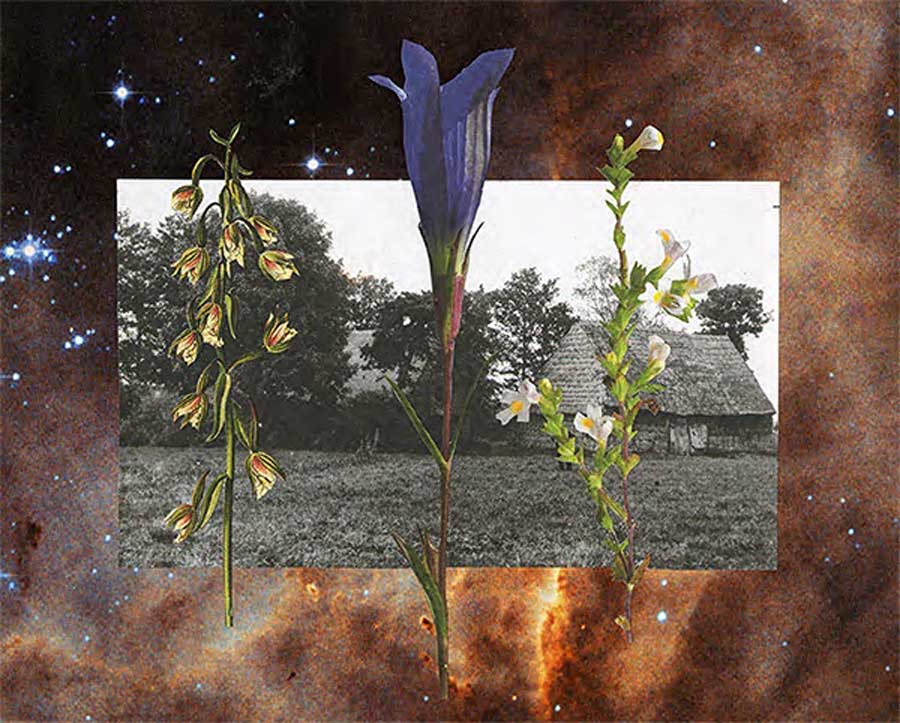
Drenthe Flora, Randy Lee Cutler. Hand cut collage, 9 x 11 inches, 2023
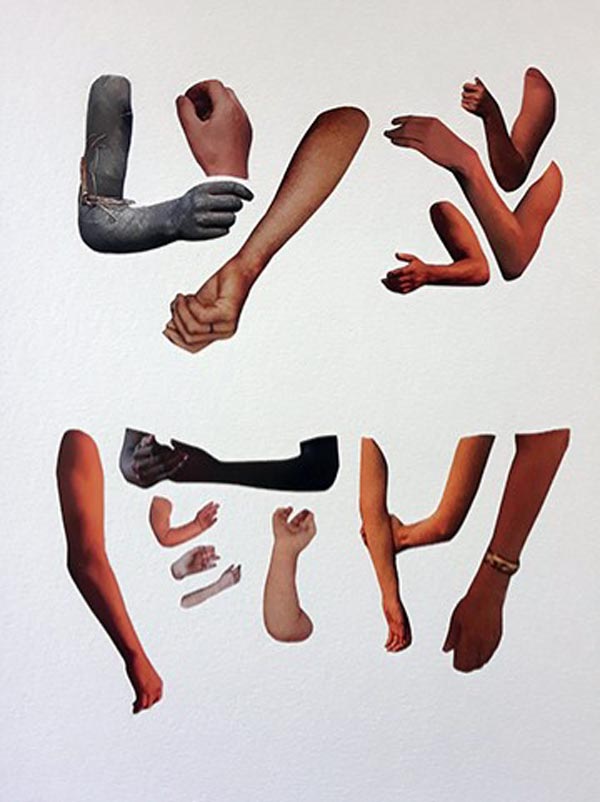
Syntax First, Randy Lee Cutler. Hand cut collage, 9 x 11 inches, 2020
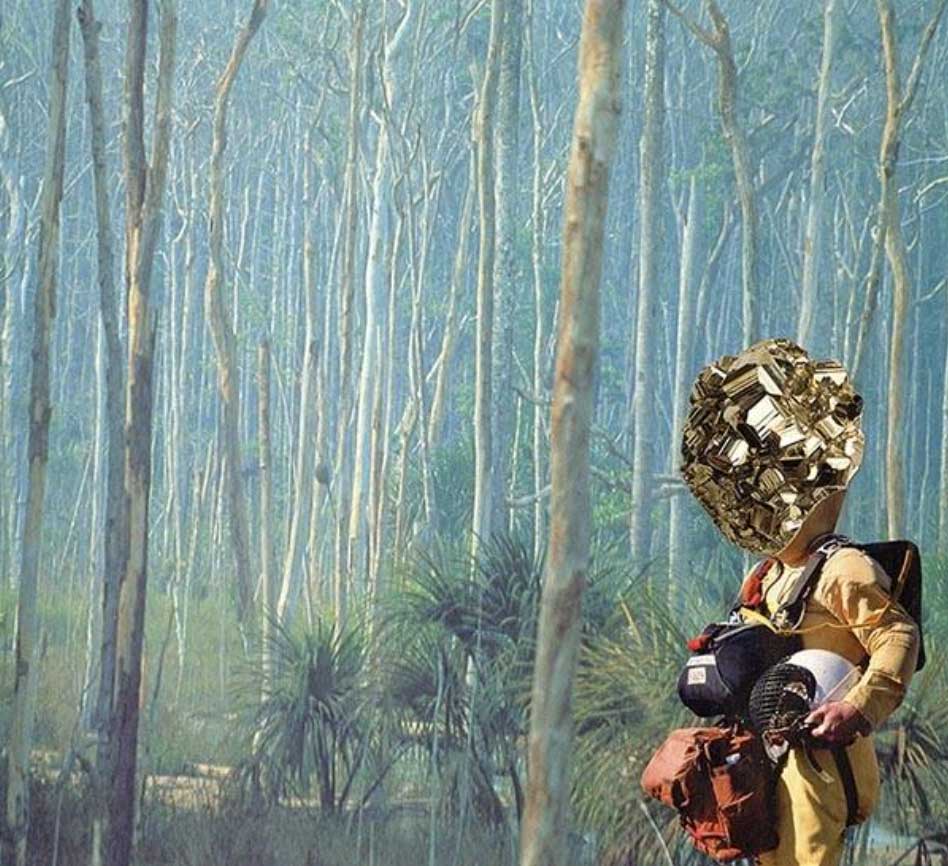
Dead Forest, Randy Lee Cutler. Hand cut collage, 27 x 10 inches, 2019
A Rip in the Fabric of Time
- Randy Lee Cutler, Emily Carr University
This artist talk explores how collage aesthetics holds compositional meaning while proposing a speculative reordering of source material. As the surrealist enterprise originally proposed, stripping images of their original context, renders them unfamiliar and strange. Then, as now, the unconscious of artist and viewer is given free rein to imagine alternate and emergent worlds. This world making or worlding allows collage to inhabit a temporal vortex, a form of aesthetic archaeology, that takes one back in time to reimagine the future. Perhaps collage is constituted by a ghostly archive of shards from the past, congealed yet nascent with emergent readings. Detached from the continuum of history, how does collaged imagery, filled with the energies of deep pasts and deep futures, blast itself free from the ceaseless flow of images? By purposefully undermining legibility, collage creates rupture in homogenous time as well as default mental and social processes. With its visual confoundments, collage introduces a rip in the fabric of time and its adjacent meanings, where we are invited to think otherwise. Drawing on Walter Benjamin’s concept of Jetztzeit or the “now-time”, this paper explores those moments where shards, sparks and energies from another time can break through and transformthe present. Benjamin’s political-poetics suggests that the artist can initiate a new order of time with our present actions. In the process we consider how collage rearranges the presumed pictorial stability of its originalmaterial by scrambling time to reveal another, more miraculous world often based on radically different principles of classification, order and temporality.
keywords: collage, speculative, worlding, now-time, pictorial stability
Taking the form of artist books, collage, performance, printed matter, sound work, artist walks and creative/critical writing, Randy Lee Cutler’s practice weaves together themes of materiality and intuition. She is fascinated with the intersection of matter and metaphor. The recent collage project Invisible Forces (2022) considered intuition, vibrational energies, and force fields as an opportunity for imagining alternate realities. The collages were transformed into a limited edition risograph zine accompanied by the essay Beyond Ordinary Sight. A previous collage project On the Other Hand (2022), worked with gifted and thrifted National Geographic magazines to address pandemic lockdowns and anti-racism initiatives. Seventy of these collages comprise the artist book OTOH and includes the essay “Unsettled Feelings”. Randy is Associate Dean of the MFA program and a Professor at Emily Carr University on the unceded Coast Salish territories also known as Vancouver, Canada.
The Surreal Collages of Toshiko Okanoue
- Julian Jason Haladyn, OCAD University
Between 1950 and 1956 the Japanese artist Toshiko Okanoue produced a series of collage reflective of a Surrealist aesthetic. With the help of Shūzō Takiguchi, the leading proponent of Surrealism in Japan, Toshiko Okanoue created photo collages that used imagery primarily taken from American magazines left in Japan after the war. Yet her specific approach, while consciously inspired by Max Ernst, demonstrates a powerful visual imaginary through the choice and juxtaposition of images. This paper examines Toshiko Okanoue’s collage practice, which has recently been re-included into the history of Surrealism, considering the specific aesthetic choices she made in several of her key collages.
keywords: Toshiko Okanoue, collage, Japanese modern art, Surrealism
Julian Jason Haladyn is an art historian, cultural theorist and Assistant Professor at OCAD University in Toronto. He is the author of several books, including The Hypothetical (2020), Duchamp, Aesthetics, and Capitalism (2019), Aganetha Dyck: The Power of the Small (2017), Boredom and Art: Passions of the Will To Boredom (2014) and Marcel Duchamp: Étant donnés (2010). In addition, he is co-editor of Community of Images: Strategies of Appropriation in Canadian Art, 1977-1990 (with Janice Gurney 2022) and the Boredom Studies Reader (with Michael E. Gardiner 2016). Haladyn is the founding Editor of Blue Medium Press, a small press publishing books that promote Canadian art and cultural scholarship.
Classroom Collages in 1930s Alberta
- Andrea Korda, University of Alberta
During the 1920s and 1930s, schoolteachers across North America were encouraged to bring cut-outs from magazines into their classrooms as instructional tools. The rationale for this practice emphasized the capacity of pictures to provide students with, in the words of educator Anna Verona Davis, “vivid experiences and accurate mental concepts” that would allow students to view “the pictured experience as reality.” However, handmade learning materials created with magazines, paper, scissors, and glue that survive in museum collections look more like Dadaist collages than like convincing stand-ins for reality. In this paper, I examine visual materials created by Alberta schoolteacher Blanche Hanson in the 1930s that repurposed glossy magazine advertisements for educational purposes. Hanson’s collages celebrate colonial histories and geographies, and show that imperialist narratives travelled freely across popular and educational media. But refocusing on the collage aesthetic of Hanson’s classroom materials and their similarities to Dadaist collage also opens up alternative interpretive possibilities, including a potential for critical and disruptive ways of looking and learning that undermine the dominant narratives circulating in early 20th-century schoolrooms.
keywords: collage, education, Dada, visual instruction, Alberta
Andrea Korda is Associate Professor of Art History at the University of Alberta’s Augustana Faculty. She is co-organizer of the Crafting Communities project and the Prairie Art Network; co-curator of the online exhibit Photographies; and author of Printing and Painting the News in Victorian London: The Graphic and Social Realism, 1869–1891 (Ashgate, 2015). Her articles on nineteenth-century British visual and material culture have appeared in the journals Word & Image, Journal of Pre-Raphaelite Studies, Journal of Victorian Culture, Victorian Network, Paedagogica Historica, and Nineteenth-Century Art Worldwide.
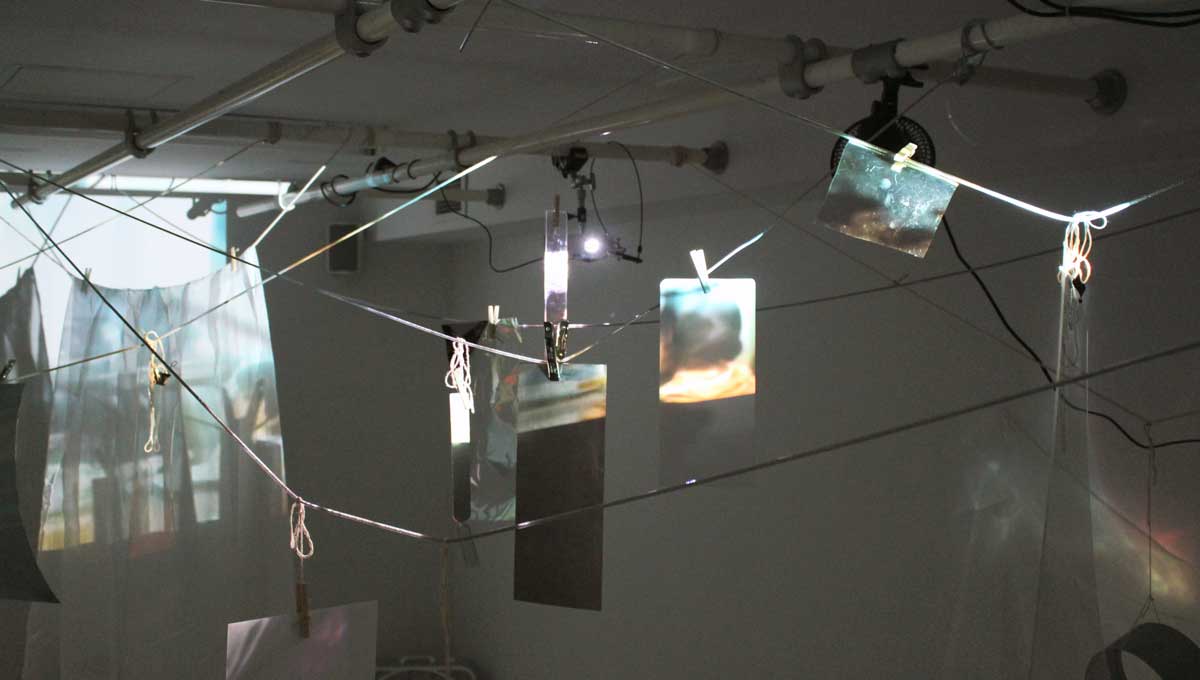
Aydan Hasanova, ondan-bundan: inquiring on culture from this and thats, Experimental Media Space, OCAD U, 2023.
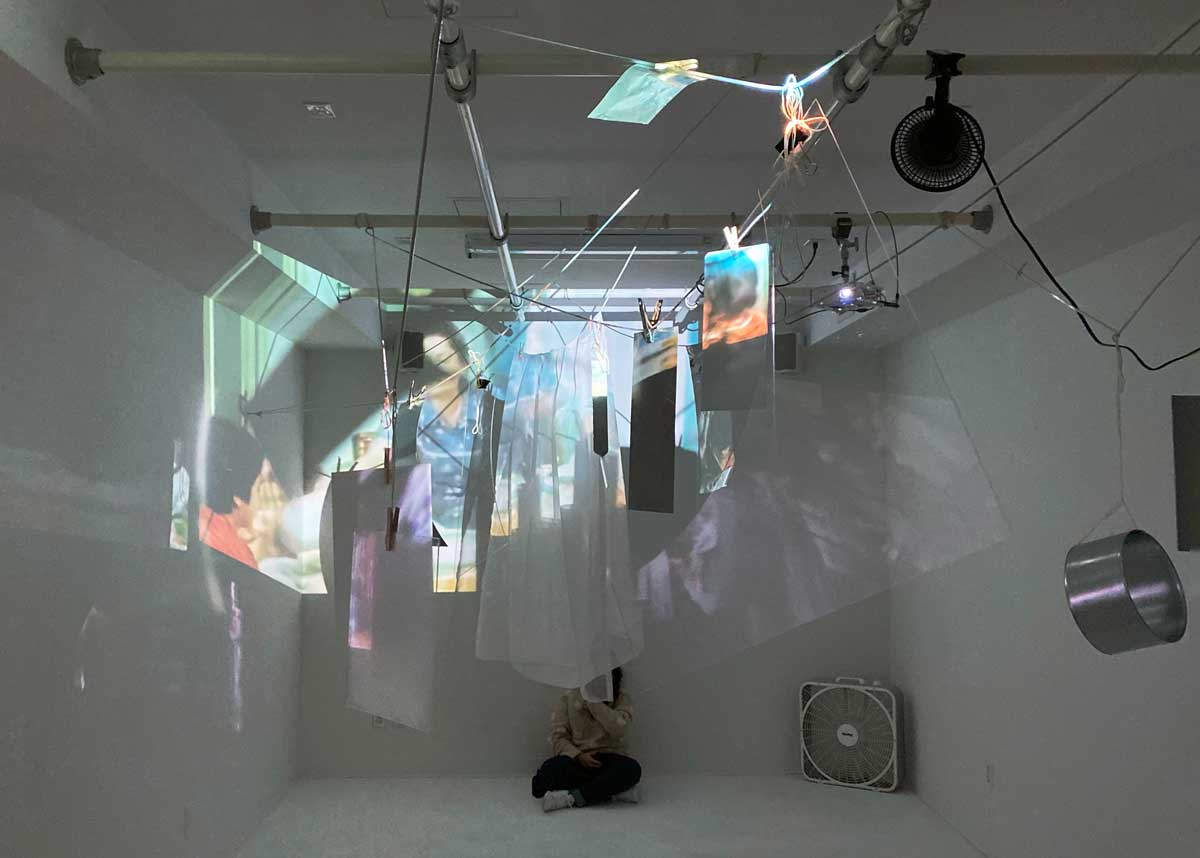
Aydan Hasanova, ondan-bundan: inquiring on culture from this and thats, Experimental Media Space, OCAD U, 2023.

Aydan Hasanova, ondan-bundan: inquiring on culture from this and thats, Experimental Media Space, OCAD U, 2023.
Assembling a Spatial Collage
- Aydan Hasanova, OCAD University
The installation ondan-bundan: inquiring on culture from this and thats plays with a collage approach. There is tension between the intentionality of bringing materials into space, the randomness of assembling and its consequent erratic dispersing effects. With this work I explored the intra-actions within Azerbaijan’s continuously changing cultural identity by fragmenting projections of Soviet Azerbaijani films with found refractive objects. The refractive objects (metal, plexiglass, mylars, fabrics) and film-images were chosen through the process of ‘locating’ culture within an existing environment (usually leftover scraps) and later assembled in space that imitated a cultural ‘sensibility.’ Through the perpetual motion created with industrial fans and the viewer’s movement in the space, the materials would sway and rotate, adding to the dispersion of the film fragments away from their stationary positions onto the wall. This movement of the fragmented images continuously produces new relationships, which I understand as a spatial simulation. This concept of ‘spatial collage’ brings a view of Azerbaijan’s culture into refraction, reconstruction, evocation, fragmentation, and remembrance as effective cultural critique. Drawing upon the reflections from the exhibited installation ondan-bundan: inquiring on culture from this and thats, this paper will further expand on the concept of ‘spatial collage’ as a mode of cultural theorization. I will be thinking through ideas of fragments in motion and walking in collaged space to explore the possibilities of spatial collage.
keywords: cultural theory, cinema, space, collage, visuality
Aydan Hasanova is an emerging interdisciplinary artist, animator and visual designer based in Toronto. They are a recent MFA graduate from the Interdisciplinary Arts, Design and Media department in OCAD. Their research explores cultural theory, Soviet cinema, visuality and feminism. Her artistic practice involves installation with found materials and projections of found film footage.
